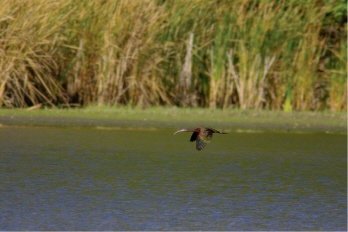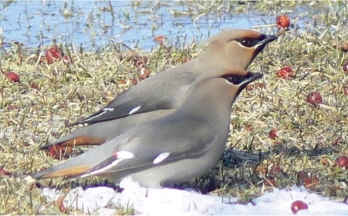The Reluctant Twitcher (16 page)

Some might consider my impatience ungentlemanly and bordering on the churlish. I myself have always mocked birders who suddenly arrive and demand to be told immediately exactly where some bird is. An old birding friend from Pelee I haven't seen in years, Al Patterson, used to tell a wonderful story. He was birding somewhere in Texas by himself, not far from a road. A guy in a huge Cadillac convertible screams up, stops, and yells to Al, “Have ya got the bird?”

Photo by
Barry S. Cherriere.
White-faced Ibis. Hydro Pond, Dundas Marsh. Having missed the few
preceding records, this bird was a first for me in Ontario.
Al naively asks, “Which bird?”
“The Beardless Tyrannulet,” the guy yells.
“Well,” says Al, “I think I sawâ”
“Look,” says the guy, “you either seen the bird or you ain't. I can't horse around all day.”
After seeing the ibis, for the first time I have an understanding of this story that entails less scorn and mockery. I think of the time I was looking for the Razorbill in late 2006 at Niagara-on-the-Lake. Nobody had seen it in the waves for several hours and finally a lady spotted it.
“Where? Where?” everybody starts yelling.
“Well, there's a boat in the background,” she says, still looking through her scope.
There are scores of boats fishing for salmon all around the area.
“Which boat?” we all cry.
“Well, it's blue,” says the lady.
There are four or five blue boats.
”Which blue boat?” we cry.
“Well, there are two guys in it ⦔
“Look,” says my neighbour, a chap from London whose name, let us say, escapes me at the moment, “just tell us where the f *****g bird is? Is that too much to ask?”
He said exactly what I was thinking. I understood it deeply. Fortunately, we all quickly got onto the bird before more urgent questions were asked. Birding can be bad for the blood pressure, you know. I won't even mention the tense hours spent trying to coax the thing across the centre of the river so we could count it as an Ontario bird. (“Here, Razorbill. Here, Razorbill. Good bird. No, you idiot, this way!”) Rarities love to hug the New York side of the river.

I have already mentioned my intense
schadenfreude
when Margaret missed the Ross's Goose on October 22. My joy at her seeing the ibis with me does not yet extend to having her knock off good birds without me. On October 23, the two of us head for Reesor Pond, determined to find the Ross's if we have to wait all day. It is teeming rain and no white geese are on the pond. Off to the north we see geese flying, and it looks like there are a few Snows among them. We see where they seem to land and set off to check them out. After a literal wild goose chase â the term has far more meaning for me now â we try one last road and see a mixed flock of Canadas and some Snows feeding in corn stubble right near the road. We stop and, without even getting out of the car, see a little
Ross's Goose
(291) looking at us shyly with its innocent and fetching eyes; a lovely little bird. Nothing mean about it like with some Canadas. It is oblivious to the driving rain and we study it as we eat a leisurely lunch. We are partial to Ross's Geese.
October 28 is a red-letter day for me. I get a freebie without even moving from my house. Without even looking out the window. No, a rarity does not come down the chimney. The phone rings. It's Margaret. She tells me that the OBRC has finally decided to put
Trumpeter Swan
(292) on the list of allowable Ontario birds, given that there is a large well-established breeding colony around the lower Great Lakes and has been for some time. Neither of us has to rush out and try to see one; we saw them repeatedly in Cobourg Harbour in the winter. This is my easiest bird all year with the possible exception of House Sparrow in our back hall. I see nothing strange about the fact that Margaret heads the OBRC and chooses this moment to heatedly press Trumpeter Swan's case. Science is science and truth will out. She couldn't help it. The timing just happened to work in our favour. And contrary to sly innuendoes and mean-spirited murmurings, no money changed hands, though I was more than willing to help out on this front. Not a glorious way to get a bird, but as Hughie says, hey, it's a tick. True, John Carley kicked up a terrible fuss and hinted that inclusion of Trumpeter Swan would compromise my whole endeavour, but his views changed magically when he realized that he, too, could now include it on his all-time Ontario list, and I heard no more grumblings. I view it as the OBRC payback for not letting me use Northern Bobwhite.
The phantom Eurasian Wigeon starts showing up again at the Dupont pond in Kingston. It wants to sucker me down yet again and have a good giggle. Well, it's not getting this boy again. Who cares if Bruce Di Labio has seen it eighty-six times and considers it the most reliable bird in Ontario. I have chased this Kingston bird seven times and missed others all over the province, as well. I read classical literature and I recognize nemesis when I see it. This is my nemesis bird for 2007. Last year it was a garbage bird for me. Had to flee them at Lee Brown's Pond; it was Alfred Hitchcock all over again. Never went to Hillman's Marsh or Cranberry Marsh in '06 without seeing one tooling around on the far shore. But this year? Forget it.
The first time Hugh and I went after the Kingston bird was in early January. It had been seen reliably in the Dupont pond, so we went for it. We arrived early. It was minus thirty degrees Celsius, but only if you completely discounted the raging wind. And it had snowed hard in the night. There were several thousand ducks on the pond, all with their heads buried deeply under their wings and with ten-centimetre triangles of snow rising neatly on their bodies. We peered for half an hour into the swirling mists above this heated pond but during this time not one duck even partially eased his head out for a look, even though the
Reisefuehrer
used every trick in his book, including the famous flapping flight simulation that works wonders with gulls and astounds passing psychiatrists. He began to mutter darkly about it being so cold that all the stones are frozen to the ground. I knew it was time to get him back into the car. We don't even know if they were Mallards or wigeon, or Purple Gallinules for that matter.
I went back several times alone during the next few days. One day I looked at over five hundred American Wigeon in the surrounding area and conceived a powerful dislike for wigeons in general. I'd rather look at bastard Mallards racing for the bread loaf in Cobourg Harbour any day. Even Long Point failed me with both Hugh and Margaret on separate trips.
So when Margaret calls on October 29 and says we have to go to Kingston and get the now reappearing Eurasian, I am less than enthusiastic. But I can't say no because Margaret doesn't even
need
the bird and she is determined to help me. Of course, when we arrive the bird is not in the pond. Surprise. While Margaret is scouring the water for other ducks, for something to do I begin scoping a large flock of ducks beyond the pond in the bay. I suddenly see a Eurasian Wigeon and shout with unrestrained joy and glee. I show it to Margaret who is uncharacteristically unenthusiastic and mumbles something about hybrids under her breath. I look again and, sure enough, something is not right. It is a bloody hybrid Eurasian/American â and uncountable. Margaret tries to rally me by talking about how interesting it is to see this bird, but I am neither interested nor consoled. It's not a tick. I stifle my racking sobs â the ABA considers it unmanly to cry in the field and most crack birders wait until they are safely at home in their bedrooms â and carry on bitterly scoping American Wigeon in the large flock. But there is a bird god â not often benevolent, I admit â and I find the real
Eurasian Wigeon
(293) almost immediately. The decision was made that I had suffered enough and paid the going price and the bird was delivered unto me.
The beat goes on. A Pacific Loon is reported on Ontbirds off Oshawa Second Marsh, and Margaret and I are up with the hens to see it next morning, November 3. The good news is that the lake is calm. The bad news is that there are hundreds of Common and Red-throated Loons out there and we are alone. We hit several suspicious birds but nothing we can honestly make into a Pacific, until we finally settle on one bird and really give it a going over. Though distant, it eventually â no doubt grudgingly â yields up all its field signs. It is a
Pacific Loon
(294). Seeing our body language, Jim Fairchild, who has been taking his time coming toward us up the beach, breaks into a run.
“Have you got the Pacific?”
“It's in my scope, Jim.”
Jim has a good look and we all congratulate ourselves and leave. Later, no one re-finds this bird. They don't show themselves to just anybody.
Keeping the roll going is important. Bohemian Waxwings are showing up all over and Margaret and I
need
one. The latest report has them way up at Willow Beach on Lake Simcoe. We decide to go for it on November 4, assuming we will almost certainly get Bohemian on the way and probably Pine Grosbeak to boot. We don't. We drive all over the proverbial hell's half acre en route and nary a waxwing. It is on this trip that my strong dislike of Fall Webworm really crystallizes into intense hatred. Who would invent an insect that makes nests that look just like birds after the leaves are down? They can weave waxwings (both Cedar and Bohemian) and kingbirds, and they do a mean Pine Grosbeak. Fortunately, few are good enough to do raptors and I have only seen one creditable screech-owl. They have run amok in Ontario this fall. It's perverse. By the time we hit Willow Beach we have more or less thrown in the towel. We drive down the side streets in despair and see a tree full of birds that are not starlings. They appear to be waxwings. We open the window and hear quiet trilling.
Bohemian Waxwings
(295)! â thirty-five to be exact. We are happy to get these marauders and vagrants because one can so easily miss them. Pine Grosbeaks are a much easier bird to find, especially if you are not cursed.

Photo by
Andrew Don.
Bohemian Waxwings. Simcoe. These restless travellers love small red
crab apples.

